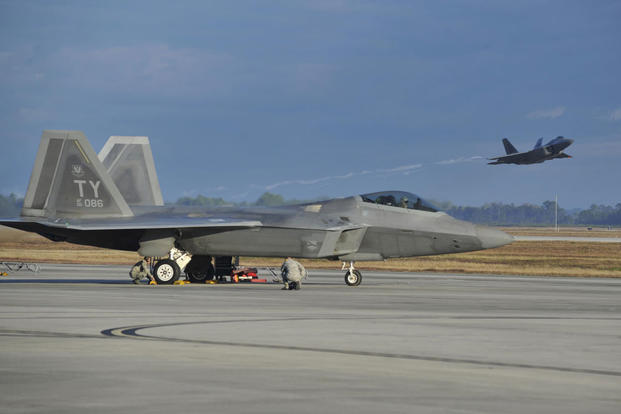Editor's note: On April 19, U.S. Air Forces Central Command released new information contradicting its previous statements about the F-22 in Syria.
"U.S. Air Force F-22 Raptors played an integral role in protecting ground forces during and after the multinational strikes against Syrian chemical weapons production facilities on the morning of April 14," AFCENT spokesman Mark Graff said. He did not provide any additional details about how many F-22s had participated in the overwatch mission, or in what regions of Syria they had operated.
The F-22 Raptor is fast developing a reputation as the aircraft that gets left behind during combat ops.
The Air Force fifth-generation stealth fighter was not flying alongside a pair of B-1B Lancer bombers that dropped missiles on Syrian targets. Nor was it conducting overwatch in the area as the bombers for the first time deployed the Joint Air-to-Surface Standoff Missile-Extended Range in combat during Saturday's strikes against a chemical lab and two equipment facilities, according to U.S. Air Forces Central Command.
"Among the options considered, leveraging the B-1B to launch stand-off weapons from outside Syrian airspace was the preferred [course of action] for a number of reasons, including minimal risk to aircrew and aircraft, and the precise destructive capability of the JASSM-ER," spokesman Lt. Col Damien Pickart told Military.com on Monday.
While British Tornado and Typhoon and French Rafale and Mirage fighters participated in the strike, Defense News reported over the weekend that F-22s weren't present. Instead, Marine Corps EA-6B Prowler electronic warfare aircraft provided support. (The B-1 itself also has some signal jamming capabilities).
Some F-15C Eagles and F-16C Fighting Falcons were reportedly spotted as a part of the mission as well, according to The Aviationist.
Related content:
- Navy Vessels, B-1s Obliterate 3 Syrian Targets in Strike
- The F-22 in Syria: Deconflicting, Not Dog-Fighting
- The F-22 Mission in Afghanistan: Overkill or Realistic Training?
Pickart said the F-22 had remained an option for the strike. But ultimately, it was the JASSM-ER's time to shine.
"The F-22A was available, but wasn't required for the operation as planned," he said. "That said, the F-22 is well suited for the defensive counter air mission it continues to conduct over Syria, protecting coalition and partners forces on the ground and in the air."
The F-22 missed out on previous combat opportunities last year. In separate incidents in June, F-15 Strike Eagles and an F/A-18 Super Hornet had encounters with adversarial aircraft.
On June 8 and again on June 20, Air Force F-15Es shot down Iranian-made Shaheed drones over At Tanf as the unmanned aerial vehicles approached or dropped munitions near U.S.-backed forces on the ground.
On June 18, a Navy F/A-18E Super Hornet conducted the U.S. military's first air-to-air kill involving a manned aircraft in nearly two decades when it downed a hostile Su-22 Fitter south of Taqbah.
"We put the F-22s in the highest-threat areas as much as we can, but they can't be there 24/7," Brig. Gen. Charles Corcoran, commander of the 380th Expeditionary Wing, Al Dhafra Air Base, United Arab Emirates, told Military.com later that month. The 380th houses the F-22 mission for the Middle East.
"Nobody's sad about not getting a kill," said Corcoran, himself an F-22 pilot. "We're happy that everyone's doing their job."
Officials told Military.com the F-22 isn't necessarily showcasing its role as an air-to-air fighter in the conflict. Instead, the twin-engine jet is doing more deconfliction of airspace than dog-fighting.
The plane has the ability to identify other aircraft, down to the airframe, and detect surface-to-air missiles and relay their existence to other friendly forces while maintaining a low-observable radar profile.
The Raptor finally made its combat debut in Afghanistan on Nov. 19, conducting a ground-attack mission to pummel suspected drug labs in the country with small diameter bombs.
Some criticized the use of such a high-end fighter for the role, but at the time, ground commanders and Air Force counterparts applauded the Raptor's employment.
The Raptor "was used because of its ability to deliver precision munitions, in this case, a 250-pound bomb, small-diameter, that causes the minimal amount of collateral damage," Army Gen. John Nicholson, commander of the NATO-led Resolute Support mission and U.S. Forces Afghanistan, said at the time.
The Air Force, meanwhile, has somewhat shifted its position and endorsed the view that perhaps hitting drug labs is meant for light-attack aircraft such as the A-29 Super Tucano.
Speaking at the Heritage Foundation in March, Air Force Secretary Heather Wilson made the case for the service's ongoing light attack experiment, "rather than taking out narcotics facilities in Afghanistan" fifth-gen fighters "like the F-22" can skip out on such missions and instead prepare for the high end fight against adversaries like Russia and China.
Similarly in February, Wilson told audiences the same thing during a Mitchell Institute breakfast.
"We should not use F-22s to destroy a narcotics factory in Afghanistan," she said, according to Breaking Defense.
-- Oriana Pawlyk can be reached at oriana.pawlyk@military.com. Follow her on Twitter at @orianapawlyk.










